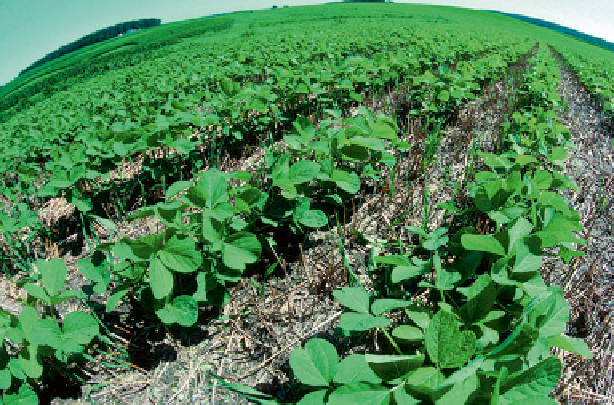Agriculture Reference
In-Depth Information
Fig. 13.2
Soybean in a zero-till farming system
Tillage of the soil stimulates microbial
decomposition of soil organic matter, which
results in emissions of CO
2
to the atmosphere.
Therefore, minimizing the amount of tillage
promotes sequestration of carbon in the soil. In
the last decades, advancements in weed control
methods and farm machinery now allow many
crops to be grown with minimum tillage (Smith
et al.
2008
).
Conservation tillage is any method of soil
cultivation that leaves the previous year's crop
residue (such as cornstalks or wheat stubble) on
fi elds before and after planting the next crop to
reduce soil erosion and runoff, as well as other
benefi ts such as carbon sequestration (MDA
2011
). With this technique, at least 30 % of the
soil surface is covered with crop residue/organic
residue following planting (Dinnes
2004
). It
also features non-inversion of the soil. This type
of soil tillage is characterized by tillage depth
and the percentage of surface area disturbed.
For example, to plant the crop in Fig.
13.2
, the
planter was adjusted to place the seed 50 mm
deep and provide a layer of fi ne tilth 18 mm
deep across the planted row areas in order to
incorporate Trefl an, which was sprayed in front
of the machine. This was all completed at
20 km/h.
Conservation tillage methods include zero-till,
strip-till, ridge-till, and mulch-till.
(i)
Zero-tillage
: Zero-tillage is the extreme
form of conservation tillage resulting in
minimal disturbance to the soil surface.
Zero-till involves planting crops directly
into residue that has not been tilled at all
(MDA
2011
). Zero-tillage technology is
generally used in large-scale agricultural
crop cultivation systems because large
machines are required for planting
(Fig.
13.2
). For smaller-scale farms, no ade-
quate machines are available for sowing,
although very small-scale farmers may do
so by hand. In zero-tillage, crops are planted
with minimum disturbance to the soil by
planting the seeds in an unplowed fi eld with
no other land preparation. A typical zero-
tillage machine is a heavy implement that
can sow seed in slits 2-3 cm wide and
4-7 cm deep and also apply fertilizer in one
operation (CIMMYT
2010
). The machine
contains an inverted T-type furrow opener
to open the slits (Fig.
13.3
). The seed and
fertilizer are placed in corresponding boxes
and dropped into the slits automatically.
The depth of the slits may be controlled by
a hydraulic mechanism from the tractor.

Search WWH ::

Custom Search